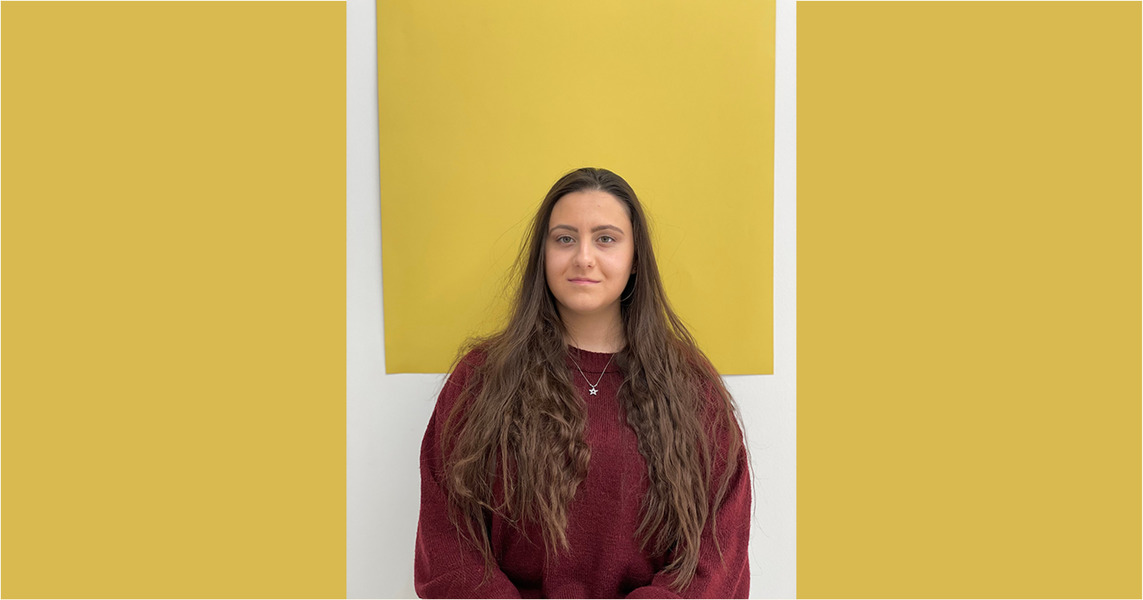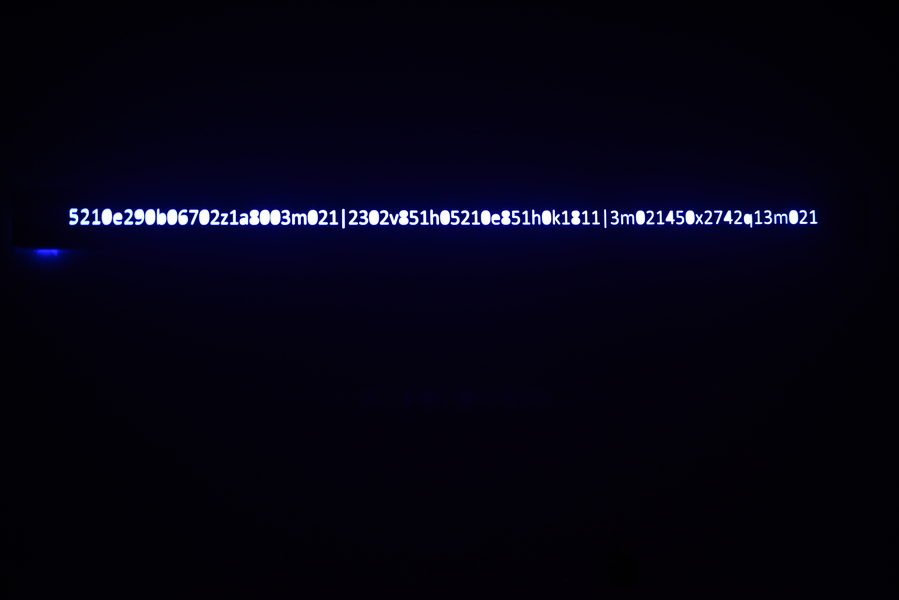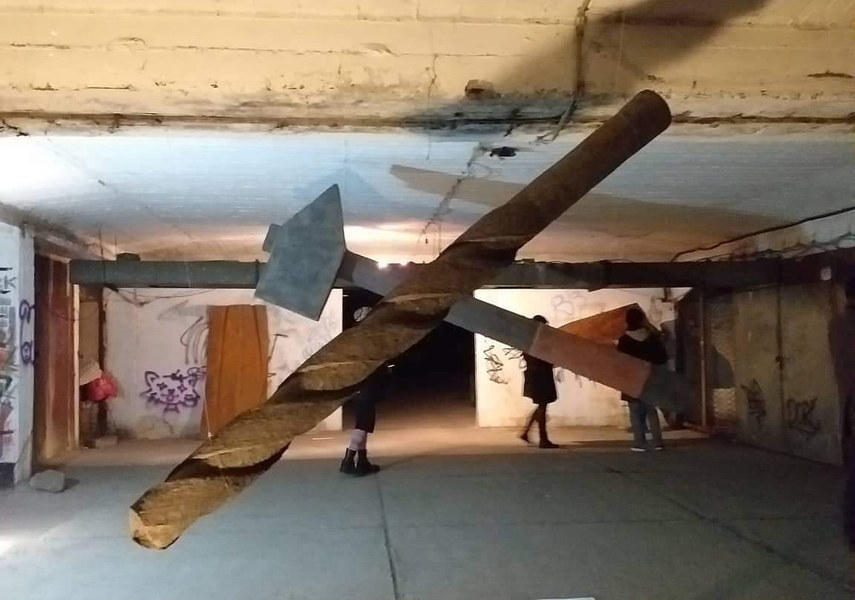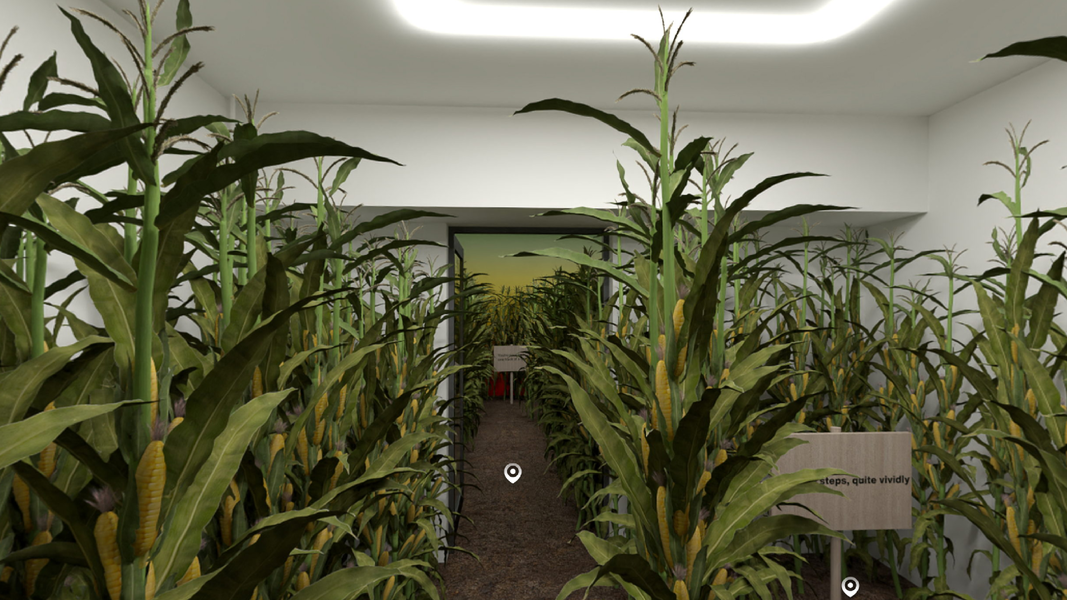Dragana Pendovska talks about her emerging artistic practice and the virtual exhibition Stepping into the cornfield
Published on: 22.07.2021
This conversation took place on February 4, 2021 as part of our PrivatePrint Meets series of conversations and was continued on June 23, 2021. Dragana Pendovska talks about her newly started artistic practice, her views on art as a young artist, as well as our collaboration for the virtual exhibition Stepping into the cornfield as part of our VR Studio.

Dragana Pendovska
You graduated from the Faculty of Fine Arts with the exhibition "Codes" in September 2020. The works in this exhibition are related to language and its visual transmission. You create your own language that conveys information, which is a very interesting story. Tell us more about this project.
The code used for that exhibition was actually created many years ago, when I was very young, somewhere in the third or fourth grade. I created it because I lacked privacy. For example, I would like to write something, but I was afraid that someone will read it or even make fun of it. Because of the great frustration that my privacy was limited, I had no choice, I had to create something that would look like a scribble to anyone else. Written numbers and letters, which seem to mean nothing to everyone else, completely imperceptible, invisible to everyone but me. That's how I started creating the code and even, for fear that someone might break it, I created multiple versions. The interesting thing is that from the moment I finished the code, it remained written only on a piece of paper until the realization of the graduation exhibition. Initially the idea for this exhibition was science, in the sense, I wanted to apply chemistry and physics in the works. However, with the outbreak of the pandemic, and after talking to my professor and mentor Nanevski, I concluded that this idea was going to be a bit difficult to realize, because what I wanted to do required a lot of dangerous chemicals. And I went back to the codes. I told the professor about the code and its background story. He liked it very much and then I realized that this is what I should go with, because that was the most intimate thing I had, and it is exactly how I would’ve wanted to mark the ending of my four-year story at the Faculty of Fine Arts.
The code is literally and completely me. Everything I would like to say, but I cannot - I will convey in writing, because not only would that be easier for me, but it’s also my way of transmitting voice and attitude. Although in the works I don’t actually use the code to express my emotions, but in order to visually illustrate something that could affect many others. With art you can play with absolutely everything, you can create art with everything, even numbers and letters. Language, as means of communication, is an incentive for people to start creating, communicating, connecting and having different opinions and views, outside of art and on everything that surrounds them in the world.
In this exhibition, the works are conceptual with a slight touch of minimalism. For example, the work "Out of the box", is composed of three words, you see, there are lines that divide those words: light | color | text. In that sense, the work describes itself, literally those words describe the work itself, there is light, there is text and there is color. And that’s... simplicity.

Dragana Pendovska, “Out of the box”, exhibition “Codes”, 2020. Courtesy of the artist
We first came across your work when we saw the big objects exhibited at the festival "Pod zemja polesno se dishe", 2019. Do they have anything to do with the method used with the codes, are they an introduction to that? Or are they something completely different?
They are something completely different... When I create a work, I cannot see initially whether it will be a site-specific installation, land art, accumulation, etc. The idea always comes to me first, then the thought of how I would present that idea, what I would like it to mean. Then I see what kind of work it will be and how to create the work in order to achieve the expected result in visual and physical terms and what the work wants and should convey.
And regarding those works, the idea came to me during a class. There was a big tree stump, and I was thinking what I could do with it and I looked down and saw some nails and I thought to myself: what if it was the other way around - what if the small was big and the big was small? Then the idea came to me, creating works that are bigger than they should be, a hyperbole, such as a hammer, nails and a drill. As with several other works, here too I allowed the works explain themselves in their simplicity. They are big now, and you are small.
Unlike your codes, these works are similar to pop art. For example, the Oldenburg needle in Milan or his large burgers. His approach to oversizing everyday objects is very interesting. As we can observe, the spectacular moment of the work is important to you. You want it to be so visually strong, to simply preoccupy the viewer's eye and to involve the viewer, to preoccupy the space.
In fact, I was a little inspired by the artist Richard Serra. His works "Sequence" are so big, almost like labyrinths in which you can get lost. And that changed my view on art, especially sculpture, when I realized that the way it looks, its size, shape, etc., play a big role. But space is also important here, because the work can be presented as part of and belonging to a form of art, but for almost every work, it matters greatly where will it be placed in space, as well as in what size.

Dragana Pendovska, “Relativity” and “Gravity”, festival “Pod zemja polesno se dishe”, 2019. Courtesy of the artist
Have you thought, for example, what is the next thing you would like to do?
All the time! That is the problem. For example, I have a lot of ideas for works, but all those works require a lot of finances and support to be realized. For that reason, the artist, like me and many others, still needs to make all those ideas simpler, because we don’t have great opportunities. We have no space, no working conditions, no materials. And here you come to the point where you just write down the ideas that you would use in the future. For example, today I will come up with an idea, tomorrow I will put it aside, in a folder where I will forget about it. And tomorrow I will have a new idea and do the same, the following day another one, etc...
It is interesting and ironic that once the idea visually appears in your mind, until you make that sketch, until the final result of the work, the work is never the same as the original, never.
Therefore, in order to stay on track, not to drift away, the idea remains written down, stays in the mind, while I use that time to create other "easier" works, until I get the opportunity to go back to the original idea. It doesn’t mean that I cannot realize the initial idea, but it will not be done in the same dimensions and in the way I had imagined it in the first place. The most important thing for me is that I don’t give up. If you really want it, you just have to wait for the right time and the right place to do it.
It is interesting how the idea starts out big and then it changes with the realization. We see that it is important for you, because you work with big spatial ideas, land art ideas. It is your great desire, but in the end, in essence, in our small country, you do not have the space to realize these ideas.
It is a game of freedom ...
Currently, my works revolve around that, whether I would want to convey some information, but I am starting to hesitate. Should I convey something I would like to say as an individual or start working on works related to everything that is happening in the world right now: climate change, or politics, or #blacklivesmatter? Could I express myself through these topics, or should I be more spontaneous, work just for me, on what I would like to convey?
Given your previous experiences with site-specific installations, can you compare the experience of working in virtual space and in real life, through the exhibition "Stepping into the cornfield"?
Every process of creating a work takes time, undergoes changes and some unexpected problem will always appear; and usually the initial idea differs from the end result. Which, of course, is not a bad thing. The artist experiences all those moments both while creating in virtual and in real space. The difference between working in a virtual space as opposed to real space, is that in virtual space you can play with almost every detail. This doesn’t mean that you cannot do the same in real space, but in that case the artist is much more limited when it comes to space, financial costs, performance and mistakes that delay the process even more than initially expected. While in virtual space, such errors are corrected within minutes or hours, even at no material cost. Mainly, if I am comparing my experiences with these two principles of work, I would say that with the digital, virtual way, I had the chance to develop an idea that in reality I couldn’t implement, for various reasons, and this is where I had the opportunity to be more playful. However, from my perspective, works placed in real space can have a greater impact on the audience. But whether realized in virtual or real space, what is important is that the idea for "Stepping into the cornfield" did not end up as just another sketch on paper.
The VR Studio is meant to be a collaborative project. The exhibition is created between the artist, the designer, the curator, and the works don’t exist outside the virtual space. What do you think about the opportunity for this kind of collaboration?
Every collaboration - no matter what it’s based on, how it’s realized and what it leads to - brings challenges that produce knowledge, new experiences, and meetings that turn into further connections and friendships, and opportunities for progress in our fields. Any given opportunity that allows us to share a part of ourselves, especially at a time when that seems a bit impossible or impractical, pushes us to be more ambitious, regardless of the end result. At the same time, opportunities for collaboration are moments that show us, to a certain extent, how much and what we are capable of.

Dragana Pendovska, a still from the virtual exhibition “Stepping into the cornfield”, part of PrivatePrint VR Studio, 2021
Our PrivatePrint Meets program targets young artists who are at the very beginning of their careers and who create in our local context. So, having that in mind, we would like to know how do you see the environment in which you work, the art scene where you belong and the position of the artist?
In my opinion, artists create, build and enrich their inner selves and expose their vulnerability in order to be seen and heard. I believe that an artist creates a snowball reaction, by inspiring other artists and pushing them to reflect or contribute with their own work, and continue it further. Art may not play a particularly big role in the world, but it is very important because it can change many things. As music unites people, so art should unite people even more than it does now.
We all ask ourselves whether art is an impractical profession. Even from a young age when we know that we want to create art, that question is present, along with the fear - will art take us anywhere, especially here in Macedonia. But one still takes that risk, and continues their studies, hoping to succeed.
--
PrivatePrintMeets series of meetings with emerging artists from N. Macedonia is part of PrivatePrint’s project activities funded by the Prince Claus Network Partnership programme.
This year, the upgraded VR Studio is co-financed by the Ministry of Culture of the Republic of North Macedonia and made possible through our activities in the PrivatePrint Meets series funded by the Prince Claus Network Partnership Programme.